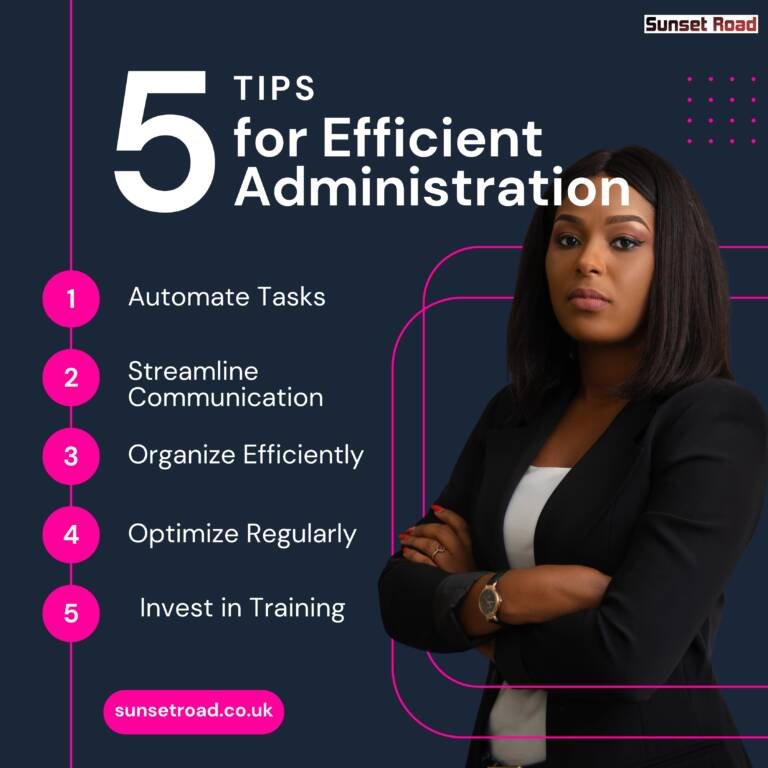Strategies for Enhancing Efficiency and Productivity
In today’s fast-paced business world, the effectiveness of administrative functions can significantly impact an organization’s success. Streamlining administrative processes is essential for improving efficiency, reducing costs, and enhancing overall productivity. This blog delves into various strategies for optimizing business administration, offering practical insights to help organizations achieve their efficiency goals.
1. Automate Administrative Tasks
Automation is a powerful tool for transforming administrative tasks, allowing businesses to reduce manual efforts and minimize errors.
Scheduling and Appointments
Managing schedules can be time-consuming. Tools like Microsoft Bookings, Calendly, and Acuity Scheduling automate appointment scheduling, allowing clients and employees to book meetings based on real-time availability. This not only saves time but also reduces scheduling conflicts and errors.
Data Entry and Management
Manual data entry can be inefficient and prone to mistakes. Solutions like Zapier and Microsoft Power Automate can automate data transfer between applications. For example, integrating your CRM with your email marketing platform can automatically update contact lists and trigger marketing campaigns, reducing manual data handling.
Communication
Automated communication tools such as chatbots and email response systems can handle routine inquiries, freeing up human resources for more complex tasks. Intercom and Drift are examples of chatbots that can answer frequently asked questions and assist customers, improving response times and customer satisfaction.
Benefits: Automation minimizes human error, accelerates processes, and enables employees to focus on strategic and high-value activities.
2. Implement Efficient Workflow Systems
Effective workflow management systems are crucial for streamlining processes and enhancing productivity.
Map Out Current Processes
Begin by documenting your existing workflows. Use tools like Lucidchart or Miro to create detailed process maps. Identify each step in your workflows, from initiation to completion, and pinpoint areas where delays or inefficiencies occur.
Select the Right Workflow Management Tool
Choose a workflow management system that suits your organization’s needs. Asana, Trello, and Monday.com offer features for task tracking, project management, and team collaboration. These tools help organize tasks, set deadlines, and assign responsibilities, ensuring a clear structure and accountability.
Continuous Monitoring and Improvement
Regularly review and refine your workflows. Utilize performance metrics and feedback from team members to identify inefficiencies and areas for improvement. Adopt a continuous improvement mindset, making iterative changes to enhance workflow efficiency.
Benefits: Streamlined workflows improve task coordination, reduce delays, and enhance overall productivity by providing a structured approach to task management.
3. Improve Document Management
Effective document management is vital for maintaining organization and accessibility. Implementing these strategies can enhance your document management practices:
Digital Document Storage
Transition from physical to digital storage solutions. Platforms like Google Drive, Dropbox, and Microsoft OneDrive offer secure cloud storage with easy access from anywhere. This shift reduces the need for physical storage space and enhances document accessibility.
Document Organization
Establish a consistent naming convention and folder structure for documents. Use descriptive filenames and organize files into clearly labeled folders. This organization system helps in quick retrieval and reduces time spent searching for documents. Tools like Evernote or Notion can further assist in managing and categorizing documents.
Version Control
Implement version control to track changes and maintain document integrity. Platforms such as SharePoint or Google Workspace offer version history features, enabling users to view and revert to previous versions of documents if necessary. This ensures that the most up-to-date information is always available.
Benefits: Enhanced document management increases accessibility, reduces physical storage needs, and improves document security by ensuring that files are well-organized and protected.
4. Adopt Effective Time Management Techniques
Time management is essential for optimizing productivity and ensuring that tasks are completed efficiently.
Prioritization
Utilize prioritization methods like the Eisenhower Matrix to categorize tasks based on urgency and importance. This approach helps in focusing on tasks that have the most significant impact, avoiding time spent on less critical activities. Prioritization also helps in managing workload and setting clear goals.
Time Blocking
Implement the time blocking technique to allocate specific periods for focused work and breaks. Tools like Google Calendar or TimeBloc can help schedule these blocks effectively. Time blocking encourages focused work periods, minimizes distractions, and enhances productivity.
Delegation
Effective delegation involves assigning tasks to the appropriate team members based on their skills and workload. This not only balances workloads but also empowers employees to take ownership of their tasks. Use project management tools to track delegated tasks and ensure timely completion.
Benefits: Effective time management improves focus, reduces procrastination, and ensures that time is allocated efficiently, leading to enhanced productivity.
5. Leverage Data Analytics
Data analytics provides valuable insights into business operations and helps optimize administrative processes.
Track Key Metrics
Monitor key performance metrics relevant to administration, such as response times, task completion rates, and process efficiency. Tools like Google Analytics and Tableau offer real-time data and insights into these metrics, helping you make informed decisions and identify areas for improvement.
Analyze Trends
Identify trends and patterns in administrative data to understand performance and areas needing improvement. For instance, if data shows increasing response times to customer inquiries, investigate potential causes and implement strategies to address the issue.
Predictive Analytics
Use predictive analytics to forecast future administrative needs and allocate resources accordingly. Predictive models can help anticipate workloads, identify potential bottlenecks, and plan for future changes in demand.
Benefits: Data analytics informs decision-making, highlights areas for improvement, and enhances strategic planning by providing actionable insights into administrative performance.
6. Enhance Communication Channels
Effective communication is critical for smooth administrative operations and overall organizational success.
Centralized Communication Platforms
Adopt centralized communication platforms like Slack or Microsoft Teams to consolidate internal communications. These tools offer features such as instant messaging, file sharing, and project collaboration, reducing reliance on email and improving information flow.
Clear Communication Protocols
Establish clear communication protocols to ensure consistency and clarity. Define how and when different types of communication should occur, and provide guidelines for both formal and informal interactions. This can help prevent misunderstandings and ensure that messages are conveyed effectively.
Feedback Mechanisms
Implement feedback mechanisms to gather input from employees and stakeholders. Surveys, suggestion boxes, and regular feedback sessions can provide valuable insights into communication effectiveness and areas for improvement.
Benefits: Enhanced communication reduces misunderstandings, improves collaboration, and ensures that information is shared efficiently, leading to smoother administrative operations.
7. Commit to Continuous Improvement
A commitment to continuous improvement is crucial for maintaining administrative efficiency over time.
Regular Reviews
Conduct regular reviews of administrative processes and performance. Evaluate the effectiveness of current systems and identify areas where changes can be made. Use performance metrics and feedback to guide these reviews and ensure that improvements are based on real data.
Employee Input
Encourage employees to provide feedback and suggestions for process enhancements. Employees often have firsthand insights into operational challenges and can offer valuable recommendations for improvement. Create a culture where feedback is valued and acted upon.
Training and Development
Invest in ongoing training and development to keep employees up-to-date with the latest tools and best practices. Provide opportunities for professional growth and encourage employees to acquire new skills that can enhance administrative efficiency. Regular training sessions can help employees adapt to new technologies and methodologies.
Benefits: Committing to continuous improvement keeps administrative practices current, adapts to changes in the business environment, and fosters a culture of innovation and excellence.
8. Integrate Advanced Technology Solutions
Incorporating advanced technology solutions can further enhance administrative efficiency and productivity.
Artificial Intelligence (AI)
AI-powered tools can automate complex tasks, such as data analysis and decision-making. For instance, AI-driven analytics platforms can provide predictive insights and recommendations based on historical data, helping organizations make more informed decisions.
Cloud Computing
Cloud computing offers scalability and flexibility, allowing businesses to scale resources up or down based on demand. Solutions like Amazon Web Services (AWS) or Microsoft Azure provide a range of services, including storage, computing power, and networking, which can enhance administrative capabilities.
Robotic Process Automation (RPA)
RPA can automate repetitive tasks across various systems. For example, RPA tools can handle invoice processing, customer data entry, and report generation. This reduces manual effort and increases accuracy.
Benefits: Advanced technology solutions improve efficiency, enhance decision-making, and offer scalability, enabling organizations to adapt to changing needs and demands.
9. Foster a Collaborative Work Environment
Creating a collaborative work environment enhances administrative efficiency by promoting teamwork and communication.
Team Collaboration Tools
Implement collaboration tools like Basecamp or Workplace by Facebook to facilitate team interactions and project management. These tools enable real-time collaboration, document sharing, and task tracking, which can improve team cohesion and productivity.
Encourage Cross-Departmental Collaboration
Promote collaboration between different departments to improve workflow and problem-solving. Regular inter-departmental meetings and collaborative projects can help align goals and streamline processes across the organization.
Create a Positive Work Culture
Foster a positive work culture that encourages open communication, recognition, and support. A motivated and engaged workforce is more likely to contribute to efficient administrative processes and overall organizational success.
Benefits: A collaborative work environment enhances communication, improves problem-solving, and fosters a sense of teamwork, leading to more efficient administrative operations.
Conclusion
Streamlining business administration is not just about adopting new tools or systems but about fostering a culture of continuous improvement and efficiency. By leveraging automation, implementing effective workflow systems, improving document management, and utilizing data analytics, businesses can significantly enhance their administrative processes. Effective time management, advanced technology solutions, and a collaborative work environment further contribute to optimizing productivity and operational efficiency.
The key to successful administrative streamlining lies in a proactive approach—regularly reviewing processes, embracing innovative technologies, and encouraging feedback from employees. This holistic strategy ensures that administrative practices remain current and aligned with organizational goals, ultimately leading to a more efficient and productive workplace.












